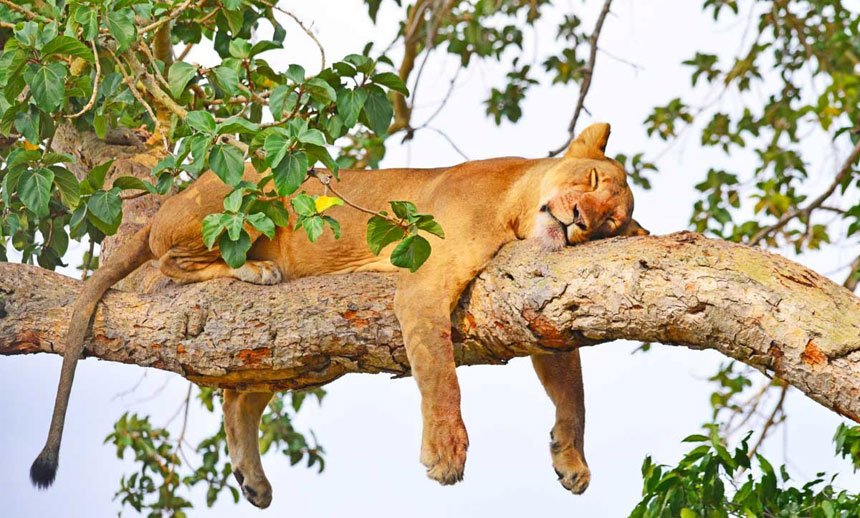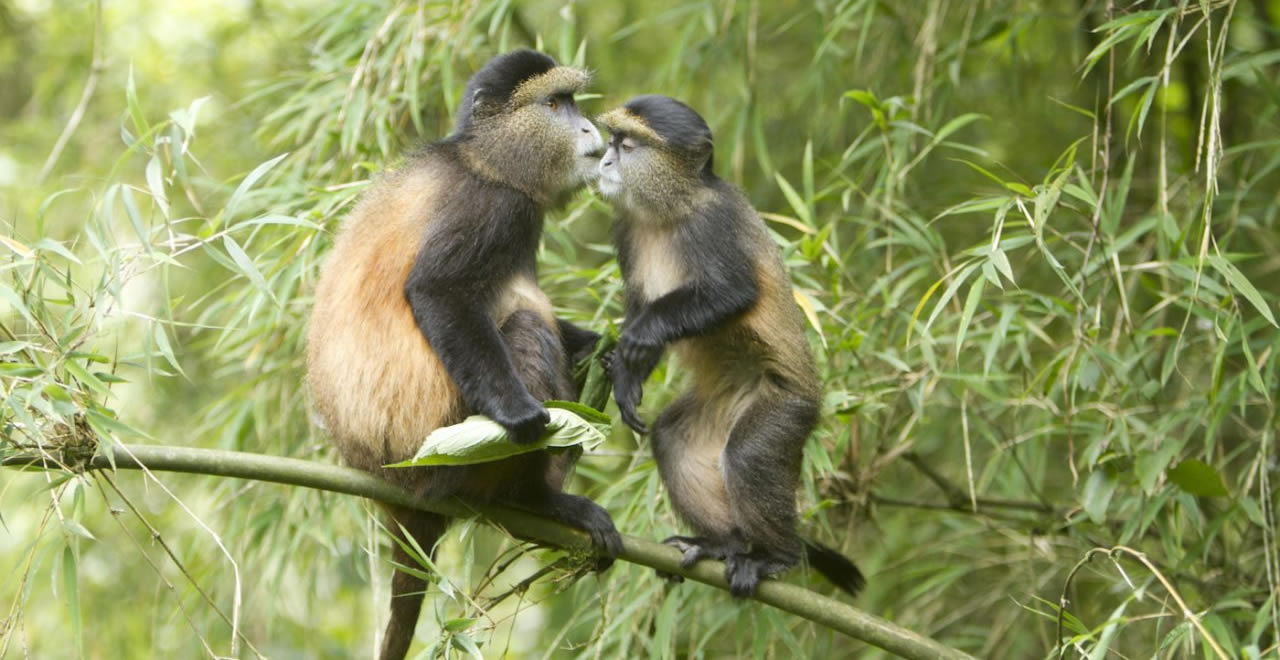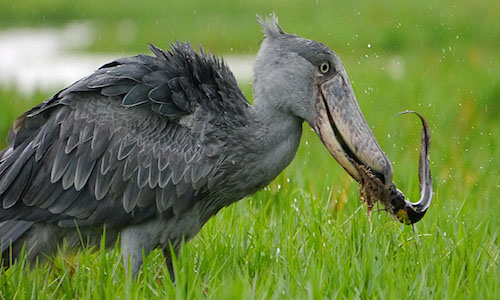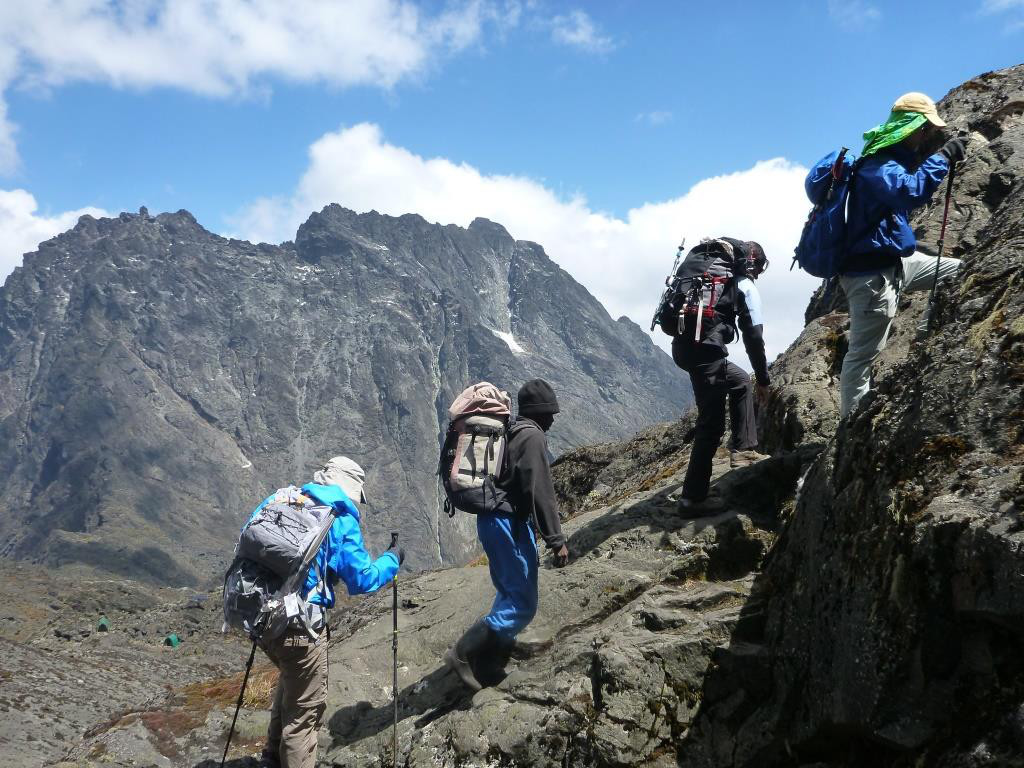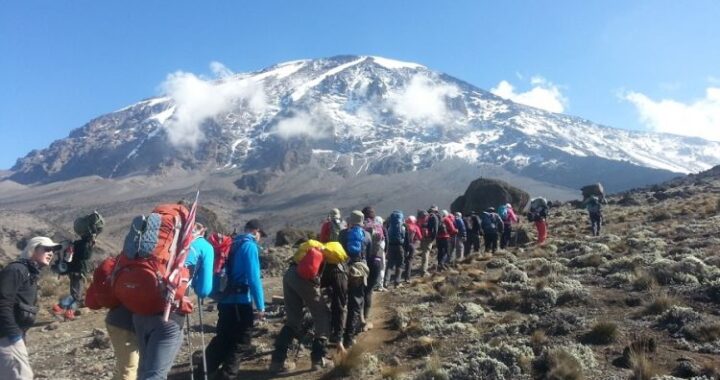Kilimanjaro National Park is located along the Tanzanian northern border with Kenya. It covers an area of 652 square miles (1,688 sq. km) which includes the montane forest that surrounds Mount Kilimanjaro. Mount Kilimanjaro is one of the 7 Natural Wonders of Africa and a UNESCO World Heritage site.
Kilimanjaro National Park is home to Mount Kilimanjaro which is the tallest mountain in Africa and the tallest free-standing mountain in the world. It reaches a maximum height of 19,341 feet (5,895 m) at Uhuru Peak. Uhuru peak is part of the Kibo cone, which is one of three volcanic cones found on the mountain.
Mount Kilimanjaro and the surrounding national park area is unique compared to most national parks because almost all ecosystems are accounted for from the area between the base and summit. The summit provides for an arctic ecosystem with a trek up the mountain delivering visitors through cultivated land, rainforest, heath, moorland, and alpine desert.
Mount Kilimanjaro is the easiest climb of the Seven Summits; the “seven summits” include the tallest mountain from each of the seven continental regions. Accordingly, Mount Kilimanjaro is the most frequently climbed mountain as well.
There are seven different official routes up the mountain. The Marangu route, which includes shared sleeping huts, is considered the easiest and the most common. Failure to acclimate to the altitude is the most common reason that people do not reach the summit. The youngest person to climb the mountain was 7 years old and the oldest was 89 years old.
Wildlife is not abundant in this area; however, elephants, leopards, and buffalo may be seen in the montane forest. These sightings are not something to anticipate with a climb up Mount Kilimanjaro. One of the fun wildlife sightings is the western black and white colobus monkeys as they jump from tree to tree.
Mount Kilimanjaro is one of the Seven Natural Wonders of Africa and is affectionately known as the rooftop of Africa. There are multiple summits on the mountain with Uhuru Peak serving as the highest point. The mountain earned its wonder status from being the tallest mountain in Africa and the tallest free-standing mountain in the world.
The summit of Mount Kilimanjaro occurs at 19,341 feet (5,895 m), which is known as Uhuru Peak and part of the Mawenzi volcanic cone. There are two other volcanic cones known as Mawenzi at 16,893 feet (5,149 m) and Shira at 13,140 feet (4,005 m). Kibo is dormant and has the possibility of a future eruption; however, Mawenzi and Shira are both extinct. Kibo is also the largest of the three volcanic cones stretching across 15 miles (24 km).
The climb up Mount Kilimanjaro is an amazing experience even if you are one of the climbers who do not reach the summit because of altitude sickness or possible exhaustion. Amazing views of the surrounding plains await travelers along the way up the mountain.
A trek up to the summit allows a traveler to experience almost every type of ecological system in one single adventure. Ecosystems include cultivated land, rainforest, heath, moorland, alpine desert, and an arctic summit.
What to do and see in Kilimanjaro National Park
Kilimanjaro National Park is a UNESCO World Heritage Site and home to the continent’s highest mountain, snow-capped equatorial Mount Kilimanjaro – Africa’s highest peak (5,895m) and tallest free Standing Mountain in the world. The mountain rises from farmland on the lower level to rainforest and the slopes are home to buffaloes, leopards, monkeys, elephants, eland and abundance of birds of prey.
Famous for its climbing and hiking experiences, Mount Kilimanjaro National Park is located in Northern Tanzania right at the border to Kenya, covering an area of 1,688 square kilometres (652 square miles) and it is one of Tanzania’s most iconic destinations for visitors. It is approximately 388km from Dodoma, Tanzania’s capital city. Our trained team of professionals will ensure your venture to this World Heritage is a once in a lifetime experience and the following is a set of things which can be done by a traveller while in this area.
Materuni Water Falls
Materuni Waterfall is a spectacular 90 m waterfall in the foothills of Mt Kilimanjaro. A short but taxing hike along a forested footpath brings you to the base of the waterfall, where the water collects in a beautifully clear little pool that’s safe to swim. During the hike there and back you pass through coffee and banana farms, as well as traverse streams and small footbridges. Keep your eyes open for monkeys, duikers, birds and other small creatures.
Shira Plateau
Just a few kilometers to the west of Mount Kibo, Shira Plateau lies on one of the routes to climb up Mount Kilimanjaro. This spectacular plateau is a caldera. When you walk through the plateau, you will be stepping on the remains of a volcano that expired over 500,000 years ago. This is a beloved place for wildlife lovers due to its tremendously rich biodiversity, especially among fauna.
Chala Crater Lake
Chala Crater Lake is located in the shadow of the Kilimanjaro, on the border between Kenya and Tanzania in a caldera that was most likely formed after volcanic activity on the mountain. Our experienced and knowledgeable tour handlers will advise you about the time of the year to travel, so you can experience the clear waters of the lake that might be turquoise blue, midnight blue, or even a stunning emerald, depending on when you decide to visit.
Olpopongi Masaai Village
here the travellers learn best of culture at Olpopongi, home to one of the most authentic Masai experiences in all of Africa. You will see the Kraals in which these early settlers have lived in for a long time, while experiencing and enjoying wonderful local food, Masai family traditions and heritage, and a friendly team which sets us apart from other operators. Olpopongi is so unique that it lets you experience authentic Masai culture without disrupting their daily lives or intruding into their private homes and villages.
Kibo Peak
Kibo Peak is one of the best areas where every traveller, should try to climb to the top of the world. It’s one of the three volcanoes of Mount Kilimanjaro, and is the highest peak of mountain Kilimanjaro and Africa! Magnificent views all year round guaranteed. This is the only peak that retains its snow throughout the year. You will learn a lot about this place through our tour handlers, knowing you are in safe hands.
Kikuletwa Hot Srings
A visit to Kikuletwa hot springs is one of the famous things which can be done while in the Kilimanjaro area and its located in the Chemka hot spring campsite. Having a swim in this hot spring would definitely mark one of the best experiences as you feel the worm water of the hot spring.
Rau Forest Reserve
This is one of the major eco -tourism based area in the Kilimanjaro region, here you can have a magnificent nature walk and bicycle riding in the forest as you have a view of other cultural ventures which always impresses visitors.
Kilimanjaro Coffee Tour
The lower slopes of Kilimanjaro are a fertile farming area thanks to melt water from its arctic summit. The coffee farmers here are famous for their 100% Arabica coffee, which has a fresh flavor and smooth texture. Tours of the coffee farms are a popular post-Kilimanjaro activity – understandably, as having an expertly brewed cappuccino or Americano after a week of roughing it on the mountain is just perfection!
Momela Lake
It’s understandable that Momela Lake is one of the beautiful areas for a traveler to visit while in the Kilimanjaro area as this lake offers an exciting canoe riding while having a great experience for bird watching more especially for avian lovers and it’s a sanctuary for various residents and migratory water bird species.
Walk in the Rim of Ngurdato Forest
This 4 km-wide caldera is a beautiful and lush oasis for wildlife. Sometimes called the ‘little Ngorogoro Crater’ (quite understandably, given its similarities to Ngorongoro Crater), the crater differs from its famous counterpart in being a no-go zone. To protect the wildlife, visitors are only allowed to hike along the western and southern rims of the crater and look down on the animals. As it’s a relatively shallow caldera (only 100 m deep), the view of the crater floor and its many denizens is the perfect eco compromise.
Routes/Trails of Mount Kilimanjaro
There are several routes that lead to the summit of Mount Kilimanjaro
Southern Routes: Marangu, Machame, and Umbwe are the three routes that ascend from the south.
Western Routes: Lemosho, Shira, and Northern Circuit are the three routes that ascend from the west.
Northern Route: There is only one route that ascends from the north known as Rongai.
The Marangu Route, affectionately called the Coca Cola Route, is one of the mosts popular routes for the traditional visitor. It features one of the more gradual slopes as well as provides sleeping huts along the way. It is the oldest and most established route.
Lemosho Route
The Lemosho Route is often considered the most beautiful of all the trekking trails on Mountain Kilimanjaro. It shares a portion of the same path as Machame route, although it holds a few advantages over that route that definitely make worth considering, particularly for travellers who have some extra time.
Starting from the western flanks of Mount Kilimanjaro at the Londorossi gate, the Lemosho Route wanders its way up one of the more remote sections Kilimanjaro. It is one of the newer routes on the mountain.
The trail takes hikers through a beautiful rain forest where they might have the chance to spot wildlife along the way. Black and white colobus monkeys are routinely seen in the forests, as are blue monkeys, small lizard and a wide assortment of birds. From there, the path wanders out onto the Shira Plateau, crossing it from west to east on relatively flat and easy to walk terrain.
The early days on the Lemosho Route provides plenty of solitude, as this trail sees far less traffic than Machame route and Marangu route. This makes an already-great trekking adventure even more spectacular as at times it will feel like you have the entire mountain to yourself.
Eventually however, Lemosho route merges with Machame route, and the amount of traffic begins to increase. But if you’re looking for a little peace and quiet in the early going of the climb, this is a great option.
Because it follows the Machame Route for a portion of the climb, much of the same scenery is found on Lemosho route as well, including the Lava Tower and Barranco Wall. But, in those first few days this trail offers some unique views of the surrounding landscapes that aren’t visible from any other place on the mountain.
Travelers will get the chance to wander through pristine rain forests and hike up to the Shira Plateau, where once above the tree line stunning vistas await.
Because of its remote nature and lengthier route, Lemosho takes a few extra days to trek. Most people spend seven or eight days on this trail, which causes the success rate to increase fairly dramatically.
If you’re looking to maximize your chances of reaching the top of the mountain, this is certainly one of the best options to choose, particularly over Machame route and Marangu route. Despite the higher success rate however, it should be noted that Lemosho route is a more strenuous hike than the “Whiskey” and “Coca-Cola” routes.
There are certain sections of the trail that are steeper and more demanding, and of course trekkers spend an extra night or two sleeping in tents as well. Still, the advantages of this route truly make it stand out from the others, making it an increasingly popular choice for adventurous travelers.
Northern Circuit Route
The Northern Circuit route is the newest route up Mount Kilimanjaro and arguably the best. That’s because the combination of all of the best elements of the other routes, rolled into one fantastic hike. If you’re looking for beautiful scenery, plenty of solitude, a healthy challenge, and the potential to spot wildlife, this is definitely the route for you.
The Northern Circuit route follows the same route as Lemosho route for the first few days, but rather than sticking to the south side of Kibo, it turns to the little-used northern trails instead.
This path is virtually devoid of other trekkers and as a result, the campsites are quiet, peaceful, and practically deserted.
Because the Northern Circuit route is longer than the other trails, it gives trekkers a chance to take in more of the mountain. Not only do they get a chance to hike across the awe-inspiring Shira Plateau, they’ll also catch glimpses of Kibo Peak and Uhuru Summit along the way.
It also provides amazing views down onto the open plains that are found to the north of the mountain, something that is seen by only a handful of other hikers while climbing Kilimanjaro.
Marangu Route
The Marangu Route is the oldest and most well established trekking route on Mount Kilimanjaro, and it remains extremely popular, despite a wide variety of other options becoming available.
This path provides trekkers with the classic Kilimanjaro climbing experience, offering sweeping views and a wonderful hiking adventure all the way to the summit of Uhuru Peak. That said, it also has some unique aspects that set it apart from any of the other routes as well, giving Marangu route a character and feeling that is entirely its own.
One of the more interesting aspects of Marangu Route is that it is the only route up Mount Kilimanjaro that doesn’t allow camping, so instead of sleeping in tents, trekkers stay in permanent huts instead.
These dormitory-style shelters provide extra protection from the wind and rain, which makes this route a popular one for travelers climbing during the rainy season, which comes in April and May. There are 60 bunk beds each at Mandara and Kibo Huts, and 120 bunk beds at Horombo Hut
While staying at those huts, trekkers will sleep in bunk beds equipped with a simple mattress and pillow. They’ll also be able to purchase an array of candy bars, bottled water, and soft drinks, which is why Marangu route is often referred to as the “Coca-Cola Route.”
Marangu Route offers a slow, steady climb to each of the daily camps, which has given it the reputation for being an easy trek. Don’t underestimate this trail however, as the approach to the final camp can be physically demanding with roughly 1000 meters of vertical gain on that day alone.
Of course, summit day on Kilimanjaro is always a challenge no matter which direction you approach from, making the final steps onto the top all the more satisfying.
Because it is one of the shortest treks to the summit – requiring just five days reaching Uhuru Peak – the Marangu Route is a popular one with trekkers who have a limited amount of time for their climb. Acclimatize to the altitude. Because of this, Marangu route has the highest failure rate of any of the routes up Mount Kilimanjaro. Keep that in mind when choosing this option for your Kilimanjaro trek.
The Marangu Route is also the only route that uses the same path going up and coming back down. That means that while the trail is a scenic one, trekkers will experience the same sites going up as they do going back down. And because it has traffic going both directions, Marangu can also get overly crowded at times too.
Still, for a classic Kilimanjaro experience, it is tough to top this tried and true route to the Roof of Africa.
Umbwe Route
Umbwe route is one of the shortest routes to the Southern Glaciers and the Western Breach and it’s the most hardest and challenging route on Mount Kilimanjaro.
The Umbwe Route is the trail for trekkers looking for a true climbing challenge. It is a quiet, seldom used path that can be very difficult, yet very rewarding at the same time. This is the route to choose if you want to test yourself on the slopes of Mount Kilimanjaro, far from the crowds that are found on the more common trails.
While Umbwe route is a non-technical climb, it does offer steep ascents and requires trekkers to scramble over rocks and tree roots at certain points. It is the hardest and most direct route up the mountain and even features several exposed ridges that are not for the faint of heart. The fitness and stamina of hikers may be tested along the way and it is best for experienced mountain trekkers who are looking for a challenge.
Because of its steep, direct approach, the success rate on Umbwe route is lower than some of the other routes.
To get the most out of this climb, trekkers are encouraged to be as fit and ready as possible, as this is a steady march uphill for the first few days, which is contrast to some of the other routes that make slow, steady ascents or wander up and down to aid in acclimatization.
That said, the intense challenge of trekking the Umbwe Route is made up for by the spectacular views. At times, there are stunning vistas to be seen to both the left and the right as trekkers as they make their way up the trail.
In fact, the early days of this path have arguably the best views of any part of the mountain, save perhaps the summit itself.
Umbwe also happens to be one of the quietest routes up Mount Kilimanjaro too. Because of its reputation as a difficult climb, very few people actually walk this trail, leaving it open and relatively untouched.
This helps to give trekkers the feeling that they are the only ones on the mountain until the route merges with Machame route near the Barranco Camp a few days into the hike. From there, it follows the familiar Southern Circuit below the Southern Ice Field before turning up towards the summit from Barafu Camp. As with most Kilimanjaro climbs, the descent is made along the Mweka Route.
If you’re looking for the absolutely best views on the way up Mount Kilimanjaro, and you enjoy testing yourself in the wilderness, Umbwe route will provide you with everything you seek, and then some. It is the closest thing you’ll find to a true mountaineering expedition on Kilimanjaro.
Machame Route
The most popular route to the summit of Mount Kilimanjaro these days is Machame route, and for good reason. This trail offers stunning views, a reasonable challenge, and plenty of time to acclimate, making it a good choice for those who have a bit of extra time in their schedule.
Machame route has been nicknamed the “Whiskey Route” because it is often perceived as being tougher than Marangu route, which is often referred to as the “Coca-Cola” route. Unlike that trail however, camping is allowed on Machame, which means trekkers will be sleeping in tents all the way to the summit.
Trekkers who take the Machame Route pass several well-known Mount Kilimanjaro landmarks while en route, including the famed Lava Tower and Shira Plateau. The route wanders up and down a series of valleys and ridges, which make the walk a bit more strenuous, but rewards hikers with some of the best views on the mountain.
It is for that reason that Machame route is widely considered to be the most scenic of all of the routes up Mount Kilimanjaro, providing unique and varied landscapes to pass through on each and every day. The trail starts on the south side of the mountain, passes underneath the Southern Ice Field and makes its summit approach from the Barafu Camp.
Rongai Route
Rongai route ascends Mount Kilimanjaro from the north-eastern side of the mountain, along the border between Tanzania and Kenya. The Rongai route retains a sense of unspoiled wilderness.
The Rongai route is the only route that approaches Kilimanjaro from the north. Rongai route is truly one of the more remote and wild trails on the entire mountain. Despite that however, this route offers trekkers plenty of advantages, making it a very appealing option for those looking for a unique experience on Africa’s tallest peak.
Due to its remote nature, the Rongai Route is among the least visited of all of the trails on Mount Kilimanjaro. Those who choose this path will experience peace and quiet for much of the trek, encountering few other climbers prior to reaching the Kibo Camp, at which point the trail merges with the Marangu Route for the final push to the summit.
Before that happens however, travelers will often have the path completely to themselves for hours or even days at a time, making this a good choice for those looking for solitude in a unique wilderness setting.
For travelers who have a few extra days in their schedule, Machame route is an excellent option. One or two additional days of acclimatization can make a big difference in the success rate, so trekkers who choose this route reach the summit more often, despite the fact that this is a more challenging hike than Marangu route.
One of the biggest and most intimidating of those challenges is the Barranco Wall, a steep cliff face that can look quite scary upon first approach. In reality, Barranco isn’t nearly as frightening or difficult as it first appears, although you will have to watch your step, and possibly use your hands for extra leverage while scrambling over certain sections. The climb usually takes about an hour to an hour and a half to complete, and the view from the top makes it worth the effort.
The downside of the Machame Route is that it can get crowded at times. Because it is so scenic, and offers a few extra days to acclimate, it is a popular choice for Kilimanjaro trekkers, which can make the trail and campsites very busy, particularly during the high season.
Still, if you’re looking for the quintessential Kilimanjaro experience, it is difficult to beat Machame route.
Climbing Kilimanjaro offers Machame as a seven day climb or as a six day climb. The six day variation combines days four and five, going from Barranco Camp to Barafu Camp without staying at Karanga. You Skip Karanga Camp
Shira Route
The Shira Route is a little used trail that begins near Shira Ridge. It is nearly identical to the Lemosho route. In fact, Shira was the original route and Lemosho is the improved variation. Although Shira is a varied and beautiful route, it is less favorable than its successor due to the relatively high altitude of Shira’s starting point, which is accessed quickly by vehicle. It is possible that climbers will experience some altitude related symptoms on the first day while camping at 11,800 feet.
The route approaches Mount Kilimanjaro from the west, beginning with a long drive from Moshi to Shira Ridge. The vehicle bypasses the rain forest zone and the hiking trail begins on Shira Ridge. The Shira route crosses the entire Shira Plateau from west to east in a pleasant, relatively flat hike. Then the route traverses underneath Kilimanjaro’s Southern Ice Field on a path known as the Southern Circuit before summiting from Barafu. Descent is made via the Mweka route.


